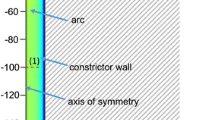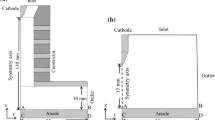Abstract
A 2D two-temperature chemical non-equilibrium model has been developed to investigate the plasma characteristics inside a DC arc plasma torch of argon. In this study the chemical kinetic model is carefully examined in order to properly capture the spatial variations of plasma characteristics, especially near the electrodes and arc fringe, where large gradients of plasma parameters exist. Two different sets of chemical kinetic processes are adopted in the calculation. The first chemical kinetic model [model (a)] includes the ground-state argon atoms, excited argon 4s state, atomic ions, molecular ions, and electrons, while the second model [model (b)] only considers the ground-state argon atoms, excited argon 4s state, atomic ions, and electrons. The predicted exit temperature and arc voltage by model (a) are in better agreement with experimental measurements. A delayed anode attachment with a higher arc voltage occurs in model (a) due to the low electron density in the upstream region of arc-anode attachment. Compared with the wide arc-anode attachment zone of model (b), model (a) exhibits a more constricted anode arc root with higher current density, which leads to a higher heat flux and temperature on the anode. This phenomenon may be explained by the rapid loss of electrons outside the arc-anode attachment zone due to the dissociative recombination of argon molecular ions. Moreover, model (a) produces a longer arc column with slightly higher maximum temperature and velocity on the axis, which is caused by its larger input energy.














Similar content being viewed by others
References
Vardelle A, Moreau C, Themelis NJ et al (2015) A perspective on plasma spray technology. Plasma Chem Plasma Process 35(3):491–509
Chazelas C, Trelles JP, Choquet I et al (2017) Main issues for a fully predictive plasma spray torch model and numerical considerations. Plasma Chem Plasma Process 37(3):627–651
Vardelle A, Moreau C, Akedo J et al (2016) The 2016 thermal spray roadmap. J Therm Spray Technol 25(8):1376–1440
Trelles JP, Chazelas C, Vardelle A et al (2009) Arc plasma torch modeling. J Therm Spray Technol 18(5–6):728–752
Westhoff R, Szekely J (1991) A model of fluid, heat flow, and electromagnetic phenomena in a nontransferred arc plasma torch. J Appl Phys 70(7):3455–3466
Li HP, Chen X (2001) Three-dimensional modelling of a dc non-transferred arc plasma torch. J Phys D Appl Phys 34(17):L99–L102
Trelles JP, Pfender E, Heberlein JVR (2007) Modelling of the arc reattachment process in plasma torches. J Phys D Appl Phys 40(18):5635–5648
Selvan B, Ramachandran K (2009) Comparisons between two different three-dimensional arc plasma torch simulations. J Therm Spray Technol 18(5–6):846–857
Trelles JP (2019) Nonequilibrium phenomena in (quasi-)thermal plasma flows. Plasma Chem Plasma Process. https://doi.org/10.1007/s11090-019-10046-1
Trelles JP, Heberlein JVR, Pfender E (2007) Non-equilibrium modelling of arc plasma torches. J Phys D Appl Phys 40(19):5937–5952
Trelles JP (2017) Finite element methods for arc discharge simulation. Plasma Processes Polym 14(1–2):1600092
Modirkhazeni SM, Trelles JP (2018) Non-transferred arc torch simulation by a non-equilibrium plasma laminar-to-turbulent flow model. J Therm Spray Technol 27(8):1447–1464
Sun JH, Sun SR, Wang HX et al (2020) Comparative analysis of the arc characteristics inside the converging-diverging and cylindrical plasma torches. Plasma Sci Technol 22(3):034012
Wang HX, He QS, Murphy AB et al (2017) Numerical simulation of nonequilibrium species diffusion in a low-power nitrogen–hydrogen arcjet thruster. Plasma Chem Plasma Process 37(3):877–895
Baeva M, Uhrlandt D (2011) Non-equilibrium simulation of the spatial and temporal behavior of a magnetically rotating arc in argon. Plasma Sources Sci Technol 20(3):035008
Liang P, Rodion G (2018) Numerical study of plasma–electrode interaction during arc discharge in a DC plasma torch. IEEE Trans Plasma Sci 46(2):363–372
Wang HX, Sun SR, Sun WP (2015) Status and prospects on nonequilibrium modeling of high velocity plasma flow in an arcjet thruster. Plasma Chem Plasma Process 35(3):543–564
Baeva M, Uhrlandt D (2013) Plasma chemistry in the free-burning Ar arc. J Phys D Appl Phys 46(32):325202
Baeva M, Kozakov R, Gorchakov S et al (2012) Two-temperature chemically non-equilibrium modelling of transferred arcs. Plasma Sources Sci Technol 21(5):055027
Liang P (2019) 2D self-consistent modeling of arc-electrode interaction in GTAW using a finite volume method. J Phys D Appl Phys 52(3):035203
Liang P, Trelles JP (2019) 3D numerical investigation of a free-burning argon arc with metal electrodes using a novel sheath coupling procedure. Plasma Sources Sci Technol 28(11):115012
Sun SR, Wang HX, Zhu T et al (2020) Chemical non-equilibrium simulation of anode attachment of an argon transferred arc. Plasma Chem Plasma Process 40(1):261–282
Sun SR, Kolev S, Wang HX et al (2017) Investigations of discharge and post-discharge in a gliding arc: a 3D computational study. Plasma Sources Sci Technol 26(5):055017
Sun SR, Kolev S, Wang HX et al (2017) Coupled gas flow-plasma model for a gliding arc: investigations of the back-breakdown phenomenon and its effect on the gliding arc characteristics. Plasma Sources Sci Technol 26(1):015003
Wang HX, Sun WP, Sun SR et al (2014) Two-temperature chemical-nonequilibrium modelling of a high-velocity argon plasma flow in a low-power arcjet thruster. Plasma Chem Plasma Process 34(3):559–577
Wei FZ, Wang HX, Murphy AB et al (2013) Numerical modelling of the nonequilibrium expansion process of argon plasma flow through a nozzle. J Phys D Appl Phys 46(50):505205
Jenista J, Heberlein VR, Pfender E (1997) Numerical model of the anode region of high-current electric arcs. IEEE Trans Plasma Sci 25(5):883–890
Baeva M, Loffhagen D, Uhrlandt D (2019) Unified non-equilibrium modelling of tungsten-inert gas microarcs in atmospheric pressure argon. Plasma Chem Plasma Process 39(6):1359–1378
Ramshaw JD (1990) Self-consistent effective binary diffusion in multicomponent gas mixtures. J Non-Equilib Thermodyn 15(3):295–300
Chang CH, Ramshaw JD (1994) Numerical simulation of nonequilibrium effects in an argon plasma jet. Phys Plasmas 1(11):3698–3708
Ridenti MA, Spyrou N, Amorim J (2014) The crucial role of molecular ions in the radial contraction of argon microwave-sustained plasma jets at atmospheric pressure. Chem Phys Lett 595:83–86
Ridenti MA, de Amorim J, Dal Pino A et al (2018) Causes of plasma column contraction in surface-wave-driven discharges in argon at atmospheric pressure. Phys Rev E 97(1):013201
Minea T, van de Steeg AW, Wolf B et al (2019) Role of electron–ion dissociative recombination in CH4 microwave plasma on basis of simulations and measurements of electron energy. Plasma Chem Plasma Process 39(5):1275–1289
Lukáč P, Mikuš O, Morva I et al (2011) Electron and gas temperature dependences of the dissociative recombination coefficient of molecular ions with electrons. Plasma Sources Sci Technol 20(5):055012
Li HP (2001) Studies of heat transfer and fluid flow in a D.C. arc plasma torch and plasma jet. PhD Thesis Tsinghua University (in Chinese)
Baeva M (2017) Non-equilibrium modeling of tungsten-inert gas arcs. Plasma Chem Plasma Process 37(2):341–370
Evans DL, Tankin RS (1967) Measurement of emission and absorption of radiation by an argon plasma. The Physics of Fluids 10(6):1137–1144
Mitchner M, Kruger CH (1973) Partially ionized gases. Wiley, New York
Moreau E, Chazelas C, Mariaux G et al (2006) Modeling the restrike mode operation of a DC plasma spray torch. J Therm Spray Technol 15(4):524–530
COMSOL Multiphysics v. 5.2a. www.comsol.com. COMSOL, Stockholm
Zhu T, Wang HX, Sun SR et al (2019) Numerical simulation of constricted and diffusive arc–anode attachments in wall-stabilized transferred argon arcs. Plasma Sci Technol 21(12):125406
Raizer YP (1991) Gas discharge physics. Springer, Berlin
Jonkers J, van de Sande M, Sola A et al (2003) The role of molecular rare gas ions in plasmas operated at atmospheric pressure. Plasma Sources Sci Technol 12(3):464–474
Cunningham AJ, O’Malley TF, Hobson RM (1981) On the role of vibrational excitation in dissociative recombination. J Phys B: At Mol Phys 14(4):773–782
Bultel A, van Ootegem B, Bourdon A et al (2002) Influence of Ar2+ in an argon collisional-radiative model. Phys Rev E 65(4):046406
Kabouzi Y, Graves DB, Castaños-Martínez E et al (2007) Modeling of atmospheric-pressure plasma columns sustained by surface waves. Phys Rev E 75(1):016402
AcknowledgEments
This work was supported by the National Natural Science Foundation of China. (Grant Nos. 11735004, 11575019). S R Sun thanks the financial support from the National Postdoctoral Program for Innovative Talents (BX20180029).
Author information
Authors and Affiliations
Corresponding author
Additional information
Publisher's Note
Springer Nature remains neutral with regard to jurisdictional claims in published maps and institutional affiliations.
Rights and permissions
About this article
Cite this article
Sun, JH., Sun, SR., Zhang, LH. et al. Two-Temperature Chemical Non-equilibrium Modeling of Argon DC Arc Plasma Torch. Plasma Chem Plasma Process 40, 1383–1400 (2020). https://doi.org/10.1007/s11090-020-10108-9
Received:
Accepted:
Published:
Issue Date:
DOI: https://doi.org/10.1007/s11090-020-10108-9




